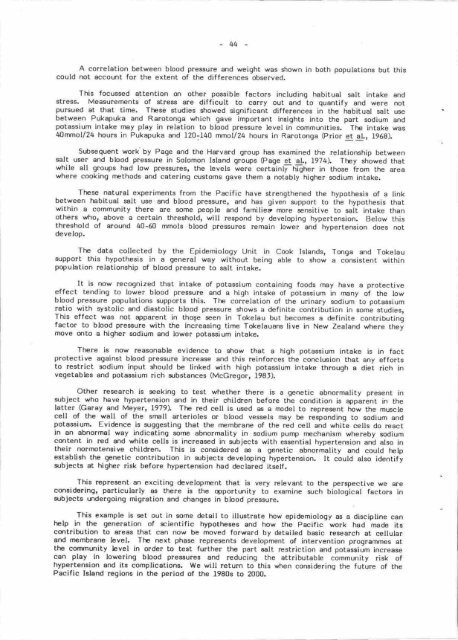Rt€@lll
Rt€@lll
Rt€@lll
You also want an ePaper? Increase the reach of your titles
YUMPU automatically turns print PDFs into web optimized ePapers that Google loves.
-44<br />
A correlation between blood pressure and weight was shown in both populations but this<br />
could noi account for the extent of the differences observed.<br />
This focussed attenLion on other possible factors including habitual salt intake and<br />
stress. Measurements of s[ress are difficult to carry out and to quantify and were not<br />
pursued at that time. These studies showed significant differences in the habitual salt use<br />
between Pukapuka and Rarotonga which gave important insights in[o the part sodium and<br />
potassium intake may play in relation to blood pressure level in communities. The intake was<br />
t0rrrnoIlZ4 hours in Pukapuka and 120-140 mmoll?4 hours in Rarotonga (Prior et e!., f968).<br />
Subsequent work by Page and the Harvard group has examined the relationship between<br />
salt user and blood pressure in Solomon Island groups (Page et !, L97q. They showed that<br />
while all groups had low pressures, the levels were cert,ainly hfuher in those from the area<br />
where cooking nrethods and catering customs gave them a notably higher sodium intake.<br />
These natural experiments from the Pacific have strengthened the hypothesis of a link<br />
between hsbitual salt use and blood pressure, and has given zupporl to the hypothesis that<br />
within a community there are some people and familier more sensitive to salt intake than<br />
others who, above a certain threshold, will respond by developing hypertension. Below this<br />
threshold of around 40-60 mmols blood pressures remain lower and hypertension does not<br />
develop.<br />
The data collected by the Epidemiology Unit in Cook Islands, Tonga and Tokelau<br />
support this hypothesis in a general way without being able to show a consistent within<br />
population relationship of blood pressure to salt intake.<br />
It is now recognized that intake of potassium containing foods may have a protective<br />
effect tending to lower blood pressure and a high intake of potassium in many of the low<br />
blood pressure populations zupports this. The correlation of the urinary sodium to potassium<br />
ratio with systolic and diastolic blood pressure shows a definite contribution in some studies,<br />
This effect was not apparent in those seen in Tokelau but becomes a definite contributing<br />
factor to blood ptessure with the increasing time Tokelauans live in New Zealand where they<br />
move mto a higher sodium and lower potassium intake.<br />
There is now reasonable evidenee to show that a high potassium intake is in fact<br />
protective against blood pressure increase and this reinforces the conclusion that any efforts<br />
to restrict sodium input should be linked with high potassium intake through a diet rich in<br />
vegetables and potassium rich substances (McGregor, fggJ).<br />
Other research is seeking to test whether there is a genetic abnormality present in<br />
zubject who have hypertension and in their children before the condition is apparent in Lhe<br />
latter (Garay and Meyer, 1919). The red cell is used as a nndel to represent how the muscle<br />
eell of the wall of the small arterioles or blood vessels rnay be responding to sodium and<br />
potassium. Evidence is suggesting that the rnembrane of the ned cell and white cells do react<br />
in an abnormal way indicating some abnormality in sodium pump mechanism whereby sodium<br />
content in red and white cells is increased in subjects with essential hypertension and also in<br />
their norrnotensive children. This is considered as a genetie abnormality and could help<br />
establish the genetic contribution in s.rbjects developing hypertension. It could also identify<br />
wbjects at higher risk before hypertension had declared itself.<br />
This rcpnesent an exciting developrnent that is very relevant to the perspective we are<br />
considoringr particularly as there is the opportunity to examine such biological factors in<br />
strbjecls undergoing migration and changes in blood pressure.<br />
This example is set out in some detail to illustrate how epidemiology as a discipline can<br />
help in the generation of rientific hypotheses and how the Pacific work had nrade its<br />
contribution to areas that can now be moved forward by detailed basic research at cellulan<br />
and rnembrane level. The next phase represents development of intervention programmes at<br />
the conmunity level in order to test further the part aalt restriction and potassium increase<br />
can play in lowering blood pressures and reducing the attributable community risk of<br />
hypertension and its complicaLions. We will return to this when considering the future of the<br />
Pacific Island regions in the period of the I980s to 2000.














![R]€@lll](https://img.yumpu.com/7594335/1/175x260/reurlll.jpg?quality=85)
